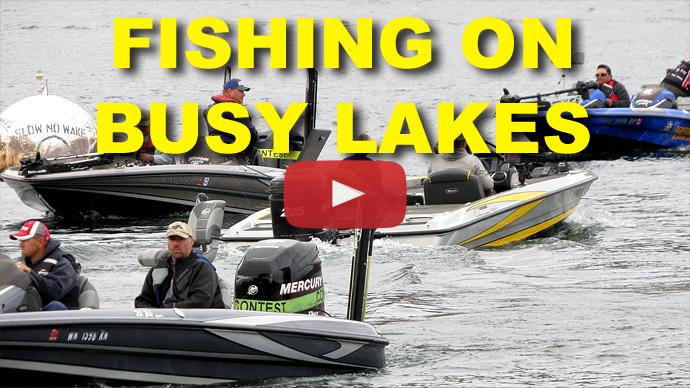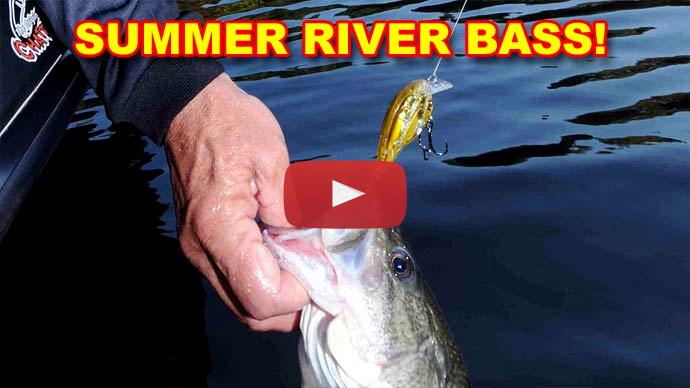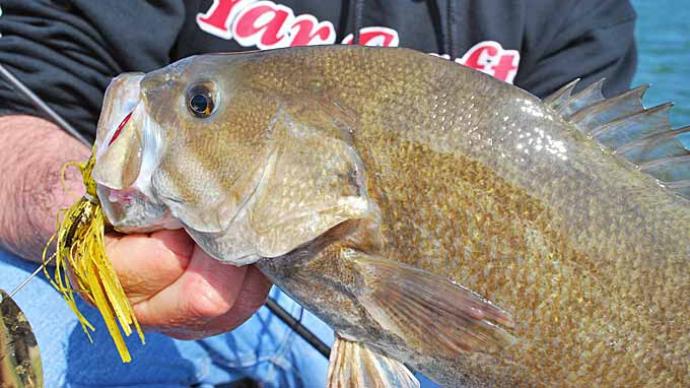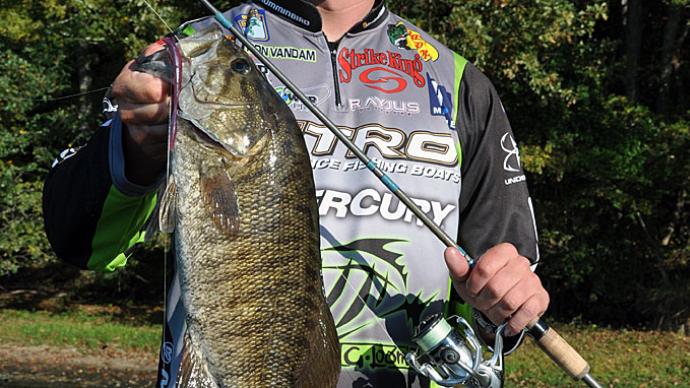Hey, folks. Glenn May here, with BassResource.com and today I want to talk to you a little bit about fishing a river and fishing current. Today, I want a huge body water, this is the Columbia River out west, I like to fish at a lot. So I'm gonna talk a lot about that. However, a lot of the principles I'm going to talk about here are applicable to smaller streams and rivers that are maybe in your neighborhood and where you like to fish.
The first thing you need to take into consideration when it comes to river fishing is that current trumps everything. It is the primary thing that drives the fish, where they're gonna be positioned and their feeding activity. On a lake, sure, there's water temperature, there is the weather conditions, there's the time of the year etcetera. That is what drives the fish behavior. That is applicable too on a river but it's the current that drives everything.
Let me give you an example. I fished the John Day River a few years ago and in the morning, it was early April, it's 25 degrees out in the morning. The water temperature was maybe 39 degrees. Typically, when you're fishing in those conditions, you're looking for one or two baits for the entire day and it might be a good fish but it's gonna be slow fishing. Well, the three of us crushed on that day. I think we kind of mauled on first moving crankbaits and we caught maybe 30 fish between the 2 of us or the 3 of us and I think the smallest fish was just a little under three pounds.
So the difference was is that it had been raining a lot the week before and there was a lot of current. It was pushing through that river really hard. So that stirred up the activity, stirred the water, got the algae going, got the insects going, got the bait fish feeding on it, got the fish feeding. That trumped all of the other conditions. So pay real close
attention to that one, what I mean by that is current itself...well, let me talk a little bit about how it's gonna position fish.
What you wanna do is look for current breaks. Anything that changes that flow of the current that’s where the fish typically are gonna set up on or could set up on. You're looking for thing like wing dams, points coming out of water, you're looking for bridge pilings, even logs and other wood debris and things like that.
Underwater you're looking for humps, drop-offs, big rocks, boulders that sort of thing that can break up that current. Even the channel bend, if it does a real sharp turn, the outside of the bend is gonna have faster moving current than the inside of the bend. The outside is gonna be deeper water, the inside is gonna be shallower water. Consequently, sometimes a lot of debris, when it floods, will stack up on those shallower inside bends and that can even block more current.
What happens is the fish set up behind those current breaks where there's slack water eddies. They sit behind that and they wait for food to come by insects, bait fish that sort of thing and they’ll dart out in the faster moving current to grab a bite and come back in the slack water.
So what you're looking for is where that faster water meets the slower moving water. You’ll see a ripple along at the top of the water. We call that a seam. That's the prime zone. That's where the fish will set up on. That's where you wanna make sure your lure goes. The stronger the current is the more the fish are gonna be positioned right directly behind those current breaks.
And if it's really strong and they snug up right behind it, it may get a little bit deeper because that's where slack water really is. Conversely, if there’s not a whole lot of current then those fish will back off away from that current break. They may even sit on top of it or even in the front of it sometimes. I've seen them do that. For example, on an Island they like to sit behind the island's bed when the current is really slow, they’ll come alongside, they’ll come up on the front. Something as that can be a really good area. If there's no really current out and it's really slack, those fish may just go out into the main channel and suspend. Okay, there's not a lot of activity going on so the baits are gonna be way off even if the rest of the conditions are perfect. Again, current trumps everything.
So how do you find these things? You wanna find these current breaks and you don't wanna spend a whole lot of time running around on a river trying to find all this stuff.
So first of all what you wanna do is get yourself a map, that's key to this. Get a map, then get another map and then get another map. Get as many maps as you can of the body of water that you're gonna fish. I've learned that there's not any one map that has everything. Even the map on your GPS unit, they don't have everything on it, and you're looking for all those things that will break up the current flow. One of the maps that I really like to get is this one, it's the River Cruising Atlas. This is one that my local area they may have been by a different name in your area but this is for navigation. You wanna find a map for navigation. If you're on a river such as this one that’s navigable there’s gonna be a lot of great information on that like where buoys are, where the channels markers are, where channels are. And I've noticed on a map like that, it will tell you like where there are shipwrecks and things like that. So little nuggets of information.
But again, every map has something different. Some will show more of the rock piles, and show wing dams and show more of the current breaks and channels and the little eddies. Where there's another one make sure you’re more with there’s say a field with a lot of stamps in it or a flat or rocky bottom. They may talk about that or vegetation or where the weeds are. Every little bit, every map has a little bit different and that's gonna give you a bigger picture of the area that you're gonna fish.
The other important part about that is you’re gonna figure out where the channel is itself. Now, when you're on a river and you're not sure where everything is, being in the channels is really important especially when you come off that channel, you need to know what's there, how shallow it is, where the bottom of your contour is because you're gonna lose a lower unit really quick. So pay a close attention to that.
If you're navigating a water like this, when you go on upstream against the current, remember that the red markers, the red marker buoys and the red channel markers are gonna be on your right-hand side. Red right returnings, think of that, “returning” returning from the ocean. That is what it means so you're going up against current. The green marker buoys and channel markers will be on your left-hand side.
The other thing I want you to pay close attention to is if you're looking at your GPS and it's telling you where the channel marker is or where the channels are and those marker buoys don't align to what your GPS is telling you, go by what the maker buoys are telling you. These rivers when they flood, sandbars move, they shift, the channel can shift and move and your map may not be completely up to date. But the channel markers they get moved around to adjust to that. I've known some of my friends that have followed the channel markers or the channels that’s on their GPS and they’ve had some damage to the lower units because the channel shifted, or it wasn't correct on their GPS. So pay close attention to those channel markers.
So again, it's current, finding those current breaks which you wanna do now, once you find those current breaks, how do you fish them? Go up ideally in a laboratory situation, you wanna fish. You wanna get kind of, you wanna move your boat, position it so it's going up against the current. Cast your bait upstream and let it drift across in the faster current through that seam that I told you about and into the eddy. Okay, that's perfect condition. You want that bait to go right across that seam so bass can come out and nail it right there.
So how I approach those on those larger current breaks is I'll actually bring the boat up, behind the eddy I'll slowly get to that. I'll be actually be on the faster moving current and I'll slowly work way into that eddy or I cast into that eddy because sometimes the fish will be in there and you can catch a few out of it before you stir them up and scare them by putting the boat right in the middle of that eddy. So work that eddy first. Then when you get into that current break, that’s when you start to throwing out into the faster moving water and bringing it right down that seam. And sometimes you can set up and you can catch fish all day long doing that, just on one spot if the conditions are right.
I like to fish Islands, the back of Islands because then I can fish the seam on one side when the bait dies down I can shift the boat around and fish the seam on the other side. Once that bait dies down I can go to the other side and pick right back up again.
The kind of baits that I like to throw, you can throw just about any bait that you use in the lakes, however, it downsize a little bit. I don't know what it is with rivers but the big huge baits don't do as well. If you're used to throwing three-quarter ounce spinnerbaits downsize to half ounce, if you're using half ounce all the time, downsize to three eights or quarter ounce. Same thing with your crankbaits, downsize a little bit and with your plastics, instead of throwing six-inch and seven-inch lizards, go down to a four-inch, go down to a three-inch tube. Tube is my favorite. I absolutely love throwing tubes on this body of water or any river because that does two things. That mimics the bait fish and also craw fish and that’s what’s abundant in these types of river systems that’s what the fish are biting on the most. So the tube is one of the most versatile baits that you can use in a big river like this.
As for color, I like to throw white, white crankbaits, white spinnerbaits and anything that mimics bait fish, perch color and sometimes I'll throw a black if the conditions are right. Not very often but black works. As far as plastics, green pumpkin works really well. That's your mainstay, that’s the bread and butter.
One thing you’ve got to think about is just because you're downsizing doesn't mean you downsize on the weight. You’ve got to go up in the weight to make sure that you can compensate for the current. So I maybe be fishing little three-inch tubes but if I put it on split shot for example, instead of using an eighth ounce or one thirty second ounce or one-sixteenth ounce weight that I normally do when I split shot, now I'm using more like a quarter ounce to a half ounce weight. I might even go up to three-quarter ounce if the current’s really strong. I know you might be thinking, what the heck! If you're going that heavy, why not use a Carolina rig? It’s for the simple fact that a Carolina rig has so many components to it, it can get hung up on the bottom. You're gonna get hung up anyways but you will get hung up less using the cylindrical weight that I use for mojo rigging and split shot rig. Same with my tube baits, I use a heavier jig head in it. Just keep in mind you’ve gotta bring a lot of your terminal tackle with you because you are gonna get snagged up on the bottom. You are gonna get to hung up, that's just the nature of doing it.
I usually rig two different ways, I have some rods that have a lighter weight and other rods that have a heavier weight because where the river opens up like this, you're not gonna have a stronger current and when it narrows down you’re gonna have stronger currents. So I wanna have the two different weights so that I can fish those very effectively without having to re-rig every time I change position.
Anyway, I hope those help. I can go on and on and on with all the different ways you can fish river. If you have any questions please leave a comment down below. I'll be happy to try and answer them. I do read all those comments and for the answers to all your questions about bass fishing visit BassResource.com.






